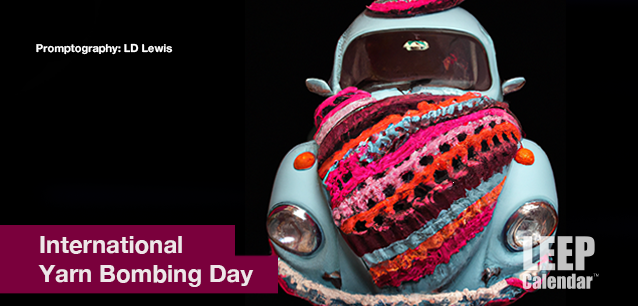 AD
AD
Today is: November 22
Scroll to explore events active on this date.
LEEP INK FEATURES

August? Absolutely!
In August, we live through the Dog Days of Summer. It's hot and often humid, and those who can leave for better climates do. Down south, winter is in full force. August is also known as "the ...

In The Heat of July: July 2025 Events
Is it hot enough (or cold enough if you're below the equator) for you yet? There is actually a day for that! Like every month, I pick a diverse collection of events you may or may not know about. This ...

May Blooms: Events in May 2025
Along with October, May is one of the most densely packed months of the year. It's before the summer humidity and the last whole month of the school year. The weather is warming in t...
About International Yarn Bombing Day
Silly , Real Estate
Retail , Politics
Ends: Jun 14, 2025
DESCRIPTION:
Yarn bombing, also known as guerrilla knitting, knit graffiti, and urban knitting, is a form of street art that uses colorful knitted or crocheted yarn or fiber rather than paint or chalk.
Yarn bombing began in the early 2000s. One of the earliest known acts was by Magda Sayeg, a boutique owner from Houston, Texas. In 2005, she decided to cover the door handle of her shop with a custom-made cozy, which garnered attention and sparked interest among locals. As she continued to create more installations, Magda found that her work brought warmth and a sense of playfulness to urban landscapes. This inspiration led her to form the Knitta Please Group, a collective of artists committed to bringing unexpected warmth to urban spaces.
As the idea took off, yarn bombing became a global phenomenon. Artists worldwide began to adorn public spaces with colorful, knitted creations, from lampposts and mailboxes to statues and even buses. This form of street art quickly grew in popularity due to its non-permanent, non-destructive nature and its ability to transform cold, impersonal urban environments into inviting and cheerful spaces.
International Yarn Bombing Day emerged in 2011 to encourage people worldwide to participate in this unique form of street art. Groups and individuals come together to create installations that range from small and subtle to grand and intricate.
While yarn bombing is generally non-destructive, it's worth noting that it hasn't been without controversy. Some critics argue that it can be wasteful, as the yarn used can become damaged or dirty when exposed to the elements, rendering it unusable for other purposes. Others have raised concerns about potential damage to trees and plants.
Whether seen as a political statement, a form of community building, or simply a way to beautify the surroundings, yarn bombing continues to captivate the public imagination with its blend of traditional craft and contemporary expression.
VIDEOS
SUPPORTING DOCUMENTS
Currently, this event does not have supporting documents.
ADDITIONAL IMAGES
Currently, this event does not have supporting images.
Where would you like to go now?
 AD
AD


/footer-logo.svg)
